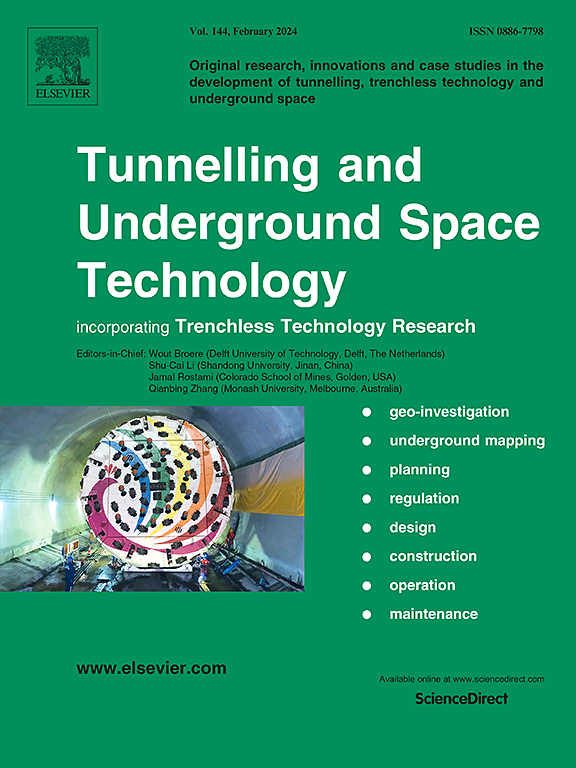Evaluation of a deformation-controlled rock bolt under various tunnelling conditions considering radial-confining-pressure-dependent bond strength
IF 7.4
1区 工程技术
Q1 CONSTRUCTION & BUILDING TECHNOLOGY
引用次数: 0
Abstract
Significant rock mass deformation exemplified by squeezing and/or swelling during tunnelling under adverse geological and stress conditions can lead to the failure of rock bolts. To address this issue, a deformation-controlled rock bolt (DC bolt) was developed in a previous study. The DC bolt was designed to accommodate large ground deformations while resisting applied load, thereby controlling the shear displacement at the mortar–bolt interface and ensuring tunnel stability. This study experimentally and numerically investigated the effectiveness of a DC bolt under various rock mass and stress conditions. It considers the evolution of the radial confining pressure acting on the DC bolts during tunnel excavation to evaluate its impact on the bond strength and mechanical behaviour of the anchor–mortar interface. To achieve this, a three-dimensional numerical model that explicitly considers the mechanical behaviour of boreholes for rock bolts was constructed. After evaluating the mechanical parameters of the DC bolt based on a laboratory experiment, a tunnelling simulation was performed considering the deformation of the boreholes and their influence on the bolt–mortar interface strength. The results indicate that the radial confining pressure between the bolt and the mortar increased to more than 5 MPa with the tunnelling depth and progression of excavation, increasing the bond strength and therefore influencing the axial force of the bolts. Furthermore, the degree of influence of the confining pressure on the axial force depended on the stiffness of the rock mass. For rock masses with very low stiffness, the effect of the confining pressure was minimal because the large deformation of the rock mass caused bond failure immediately after installation of the bolt, prior to the increase in the bond strength. Conversely, the effect is pronounced for rock masses with relatively large stiffness values, increasing the axial force by a maximum of 40 % compared to the case without the radial-confining-pressure-dependent shear strength model. This study provides fundamental insights into the design of rock bolts, the mechanical behaviour of which is dictated by the anchor–mortar shear behaviour and failure, under various stress and ground conditions.
考虑径向围压相关黏结强度的不同隧道条件下变形控制锚杆的评价
在不利的地质和应力条件下,隧道掘进过程中以挤压和/或膨胀为代表的岩体显著变形可能导致锚杆破坏。为了解决这一问题,之前的研究开发了一种变形控制锚杆(DC锚杆)。直流锚杆既能承受较大的地面变形,又能抵抗外加荷载,从而控制砂浆-锚杆界面处的剪切位移,保证隧道的稳定性。本文对直流锚杆在不同岩体和应力条件下的有效性进行了实验和数值研究。考虑隧道开挖过程中作用在直流锚杆上的径向围压的演变,以评估其对锚杆-砂浆界面粘结强度和力学性能的影响。为了实现这一目标,建立了一个明确考虑锚杆钻孔力学行为的三维数值模型。在室内试验的基础上,对直流锚杆的力学参数进行了评估,并考虑了钻孔变形及其对锚杆-砂浆界面强度的影响,进行了掘进模拟。结果表明:随着掘进深度和掘进进度的增加,锚杆与砂浆之间的径向围压增大至5 MPa以上,锚杆与砂浆之间的粘结强度增大,从而影响锚杆的轴向力;围压对轴向力的影响程度取决于岩体的刚度。对于刚度非常低的岩体,围压的影响很小,因为岩体的大变形在锚杆安装后立即导致粘结破坏,而不是粘结强度的增加。相反,对于刚度值相对较大的岩体,效果明显,与不使用径向围压相关抗剪强度模型的情况相比,轴向力最多增加了40%。该研究为锚杆设计提供了基本的见解,锚杆的力学行为取决于锚固砂浆在各种应力和地面条件下的剪切行为和破坏。
本文章由计算机程序翻译,如有差异,请以英文原文为准。
求助全文
约1分钟内获得全文
求助全文
来源期刊

Tunnelling and Underground Space Technology
工程技术-工程:土木
CiteScore
11.90
自引率
18.80%
发文量
454
审稿时长
10.8 months
期刊介绍:
Tunnelling and Underground Space Technology is an international journal which publishes authoritative articles encompassing the development of innovative uses of underground space and the results of high quality research into improved, more cost-effective techniques for the planning, geo-investigation, design, construction, operation and maintenance of underground and earth-sheltered structures. The journal provides an effective vehicle for the improved worldwide exchange of information on developments in underground technology - and the experience gained from its use - and is strongly committed to publishing papers on the interdisciplinary aspects of creating, planning, and regulating underground space.
 求助内容:
求助内容: 应助结果提醒方式:
应助结果提醒方式:


